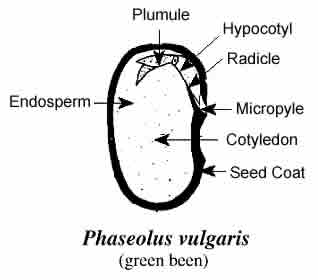 What's in a Seed? - February 29, 2012 Jeff Schalau, Agent, Agriculture & Natural Resources University of Arizona Cooperative Extension, Yavapai County As various seed catalogs begin arriving in the mail, gardeners plan their vegetable gardens and flower beds. As you visualize the flowers and fruits to come, think about the complexity and elegance of the seeds themselves. Seeds are plant embryos packaged in a small container with stored food. Mother Nature provides the technology and packaging. Seed companies just breed the plants, collect and process the fruits, put them in an envelope, and sell them to us. Seeds are the products of sexual reproduction. They contain DNA from a pollen grain and an ovule. The male and female parents can be different plants or the same plant depending on the species. As with all biological systems, there are many variations on this theme. Understanding the reproductive cycle for a given plant is critical to successful plant breeding and seed saving.  As mentioned above, a seed contains the embryo of the new plant, with a supply of food for the embryo until it has formed sufficient roots and leaves to obtain its own food. The embryo is a miniature plant in a state of arrested development. The food, endosperm, may be in the seed leaves (also called cotyledons) or it may be outside the seed leaves and be absorbed as the seed germinates. Endosperm food sources can be in the form of carbohydrates, proteins, or fats. Seeds also have a seed coat (testa) to protect them from disease and insects. The seed coat also prevents water from entering the seed which would initiate the germination process before the proper time. As mentioned above, a seed contains the embryo of the new plant, with a supply of food for the embryo until it has formed sufficient roots and leaves to obtain its own food. The embryo is a miniature plant in a state of arrested development. The food, endosperm, may be in the seed leaves (also called cotyledons) or it may be outside the seed leaves and be absorbed as the seed germinates. Endosperm food sources can be in the form of carbohydrates, proteins, or fats. Seeds also have a seed coat (testa) to protect them from disease and insects. The seed coat also prevents water from entering the seed which would initiate the germination process before the proper time.The process of seed germination is the resumption of active growth of the embryo so that it can become a plant. Prior to any visual signs of growth the seed must absorb water through the seed coat and/or an area of the seed called the micropyle. In addition, the seed must be in the proper environmental conditions; that is, exposed to oxygen, favorable temperatures, and for some, specific light conditions. Seed germination occurs in three stages. The process of water absorption (called imbibition) reactivates enzymes present in the seed. These enzymes break down storage compounds in the seed to make them available for the embryo. For example, when barley absorbs water, enzymes are activated that convert starch into sugars. Some industrious individuals use these processes to their advantage to produce malt which is used to make beer. The second stage is digestion and translocation. In this stage, enzymes that were synthesized or activated previously begin to break down storage material within the seed into simple compounds which are translocated to the embryo. The embryo begins to grow as cells elongate and divide. In the final stage, the germinating seed continues to undergo metabolic changes which transform the embryo into a seedling. The radicle is the first part of the seedling to emerge from the seed. It will develop into the primary root from which root hairs and lateral roots develop. In most broad-leafed plants, there are two seed leaves (called cotyledons) which encase the embryo and are usually different in shape from the leaves that the mature plant. The hypocotyl is the portion of the embryo which becomes the stem. These plants are often referred to as dicots. Plants producing one cotyledon are called monocots. Monocots include grasses, lilies, orchids, palms, agaves, and yuccas. The processes described above are simplified and generalized. The bottom line is that seeds are alive. Respiration requires an energy source and some minute amount of oxygen. Seed viability can be extended under cool, dry storage conditions. While there are a lot anecdotal reports of seeds remaining viable for a 1,000 or more years. Controlled experiments have documented seed viability of 100 years for a handful of species investigated. Myself, I’m happy when seeds I purchased last year germinate. With that in mind, you may have heard recently that scientists from the Russian Academy of Sciences were able to regenerate 30,000 year-old plant tissue collected from a Siberian squirrel’s burrow. The plant was not grown from a seed, but was grown using tissue culture and did produce viable seed. The plant, Silene stenophylla, is a relative of Phlox and Carnation. Here is a link to the scientific journal abstract: www.pnas.org/content/early/2012/02/17/1118386109. Follow the Backyard Gardener on Twitter – use the link on the BYG website. If you have other gardening questions, call the Master Gardener help line in the Camp Verde office at 928-554-8999 Ext. 3 or e-mail us at cottonwoodmg@yahoo.com and be sure to include your name, address and phone number. Find past Backyard Gardener columns or provide feedback at the Backyard Gardener web site: http://cals.arizona.edu/yavapai/anr/hort/byg/. |